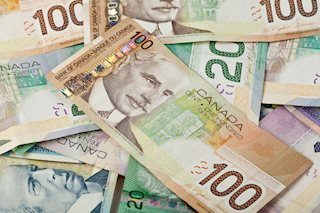USD/CAD holds losses near 1.4400 due to improved crude Oil prices
|
- USD/CAD edges lower amid thin trading volumes ahead of the New Year holiday.
- The US Dollar may appreciate due to the rising hawkish outlook for the Fed’s interest rates next year.
- The commodity-linked CAD gains ground amid improved crude Oil prices.
USD/CAD breaks its three-day winning streak, trading around 1.4400 during the European hours on Monday. The USD/CAD pair loses ground as US Dollar (USD) holds losses amid thin trading volumes ahead of the New Year holiday.
Markets continue to process the US Federal Reserve’s (Fed) hawkish stance, which could provide support for the US Dollar and the USD/CAD pair. The Fed reduced its benchmark interest rate by 25 basis points at the December meeting, the latest Dot Plot projections signal only two rate cuts in 2025, reinforcing cautious sentiment.
Fed Chair Jerome Powell said earlier this month that Fed officials "are going to be cautious about further cuts" after an as-expected quarter-point rate reduction. The Fed’s hawkish message is likely to support the US Dollar (USD) and act as a tailwind for the USD/CAD pair in the near term.
Traders broadly anticipate that the incoming administration of President-elect Donald Trump will implement tax cuts, tariffs, and deregulation, measures expected to fuel inflation. This could prompt the US central bank to adjust its outlook for the upcoming year.
Additionally, the commodity-linked Canadian Dollar (CAD) receives support from improved crude Oil prices, given Canada is the largest Oil exporter to the United States (US). West Texas Intermediate (WTI) Oil price continues to gain ground for the second successive day, trading around $70.20 per barrel at the time of writing.
However, the potential rise in crude Oil prices might be limited as the market shifts its attention to the 2025 demand outlook. Projections of an oversupplied market next year could hinder the Organization of the Petroleum Exporting Countries and its allies' (OPEC+) efforts to resume idled production. Furthermore, uncertainties surrounding future demand from China, the world’s largest Oil importer, could add additional downward pressure on crude Oil prices.
Canadian Dollar FAQs
The key factors driving the Canadian Dollar (CAD) are the level of interest rates set by the Bank of Canada (BoC), the price of Oil, Canada’s largest export, the health of its economy, inflation and the Trade Balance, which is the difference between the value of Canada’s exports versus its imports. Other factors include market sentiment – whether investors are taking on more risky assets (risk-on) or seeking safe-havens (risk-off) – with risk-on being CAD-positive. As its largest trading partner, the health of the US economy is also a key factor influencing the Canadian Dollar.
The Bank of Canada (BoC) has a significant influence on the Canadian Dollar by setting the level of interest rates that banks can lend to one another. This influences the level of interest rates for everyone. The main goal of the BoC is to maintain inflation at 1-3% by adjusting interest rates up or down. Relatively higher interest rates tend to be positive for the CAD. The Bank of Canada can also use quantitative easing and tightening to influence credit conditions, with the former CAD-negative and the latter CAD-positive.
The price of Oil is a key factor impacting the value of the Canadian Dollar. Petroleum is Canada’s biggest export, so Oil price tends to have an immediate impact on the CAD value. Generally, if Oil price rises CAD also goes up, as aggregate demand for the currency increases. The opposite is the case if the price of Oil falls. Higher Oil prices also tend to result in a greater likelihood of a positive Trade Balance, which is also supportive of the CAD.
While inflation had always traditionally been thought of as a negative factor for a currency since it lowers the value of money, the opposite has actually been the case in modern times with the relaxation of cross-border capital controls. Higher inflation tends to lead central banks to put up interest rates which attracts more capital inflows from global investors seeking a lucrative place to keep their money. This increases demand for the local currency, which in Canada’s case is the Canadian Dollar.
Macroeconomic data releases gauge the health of the economy and can have an impact on the Canadian Dollar. Indicators such as GDP, Manufacturing and Services PMIs, employment, and consumer sentiment surveys can all influence the direction of the CAD. A strong economy is good for the Canadian Dollar. Not only does it attract more foreign investment but it may encourage the Bank of Canada to put up interest rates, leading to a stronger currency. If economic data is weak, however, the CAD is likely to fall.
Information on these pages contains forward-looking statements that involve risks and uncertainties. Markets and instruments profiled on this page are for informational purposes only and should not in any way come across as a recommendation to buy or sell in these assets. You should do your own thorough research before making any investment decisions. FXStreet does not in any way guarantee that this information is free from mistakes, errors, or material misstatements. It also does not guarantee that this information is of a timely nature. Investing in Open Markets involves a great deal of risk, including the loss of all or a portion of your investment, as well as emotional distress. All risks, losses and costs associated with investing, including total loss of principal, are your responsibility. The views and opinions expressed in this article are those of the authors and do not necessarily reflect the official policy or position of FXStreet nor its advertisers.